Why businesses need to apply a Zero Trust Access (ZTA) model
As the face of cyber threats continues to change and evolve, the level of security any organization has must grow in specificity and detail across all possible attack vectors.
What is Zero Trust Access?
Zero Trust Access (ZTA) is a cybersecurity model and feature based on the principle of requiring validation of everyone who wants to access your resources, no matter who they are. No device, user, or system is trusted by default, regardless of the network in which it is operating, and regardless of whether it is inside or outside your organization’s security perimeter. This model significantly improves security around your critical resources as everyone accessing them has to be validated.
To help you visualize this - imagine a large company with many departments and employees. Each employee in each department will have to wear a company-issued employee ID to verify their status as a team member. However, not everyone will need access to every part of the company, so these cards are embedded with a chip or coding that grants users specific access to certain areas by scanning an ID pad. Not only that, they also need to type in a pin code after they scan their ID cards. This system applies to everyone from the CEO down to the most junior employee. Whenever you need access to something, you need to confirm your identity and be validated. So with ZTA, every team member is required to be validated and authorized before gaining access to your company’s resources whether that’s a server, a platform, or other systems.
According to TechTarget, there are 7 pillars of the Zero Trust model that can be applied to any organization:
Workforce security: Enhanced control over access to an organization's valuable assets is required through secure identity management. Access to data is granted only to authorized users right after their identities have been rigorously authenticated along with the use of Single Sign-On authentication methods, multi-factor authentication, context-aware policies and anomaly detection.
Device security: The primary goal of this pillar is to recognize and authorize devices when they try to connect to your network. Malicious devices must be protected from entering the internal network as well as to protect internal devices from untrusted networks.
Workload security: Each and every workload must be protected against data collection as well as unauthorized access while connecting with external apps and services. Workloads running on cloud services are especially vulnerable targets that attract cybercriminals.
Network security: Organize the internal network in a way where you microsegment and isolate sensitive resources from being accessed by unauthorized entities.
Data security: Categorize and isolate data so that only authorized people who need it can access it. The process of determining data storage locations and in-transit encrypting are also parts of this pillar.
Visibility and analytics: All the activities relating to security around access control, encryption, segmentation, data formation, and applications must be closely supervised. It is essential to give security teams complete visibility into the entire security state of the organization for ease of detecting and mitigating threats in real-time.
Automation and orchestration: The ZTA infrastructure should be automated and centrally controlled across the entire customer network in order to facilitate consistency, accuracy, and ease of use.
All businesses need to apply the ZTA model
As businesses grow over the years, their databases become more complicated coupled with growth in the number of employees requiring access to resources. It only takes just one negligent employee for the whole business to suffer heavily. To emphasize the point, the average cost of a breach in organizations that don’t apply zero trust is now up to $5.04 million US (IBM, 2021).
ZTA assists in strengthening an organization’s greatest vulnerability - the people element. ZTA increases security while giving businesses a better view into users and devices, maintaining control access of their network by strictly setting policy rules and user limits based on team member responsibilities. By doing this, the risk of cybercriminals exploiting team members is greatly reduced due to strict access authorization methods and limitations on what that employee can do while in the network.
Polaris Zero Trust Access
Polaris’ Web Application & API Protection (WAAP) platform integrates ZTA as an add-on feature (automatically included for Enterprise customers). Our Zero Trust Access is customizable in its features:
Applications: Add whatever applications that require ZTA
Providers: To manage 3rd party user authentication and authorization via SSO
Groups: To organize and set up rules for users
User: To manage individual user access controls
Login Page Configuration - Customize the look and feel of your login
Custom Access Domain - Customize the Access Domain address to fit your brand
Our ZTA model is a critical add-on for those that want greater control over user access to applications and endpoints associated with their domain. Enterprise customers have 15 free ZTA seats included in their plan. Upgrade your plan to Standard or above to take advantage of this add-on:
https://polarisec.com/cyber-security-web-protection-pricing
Sources:



